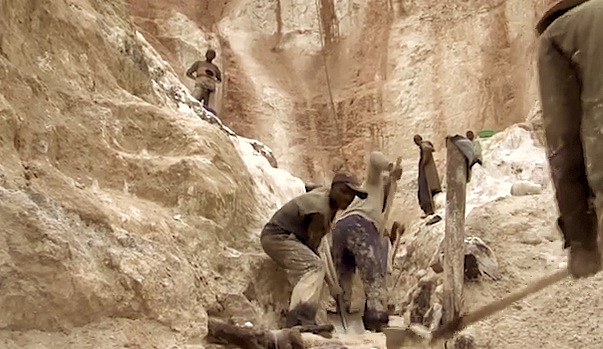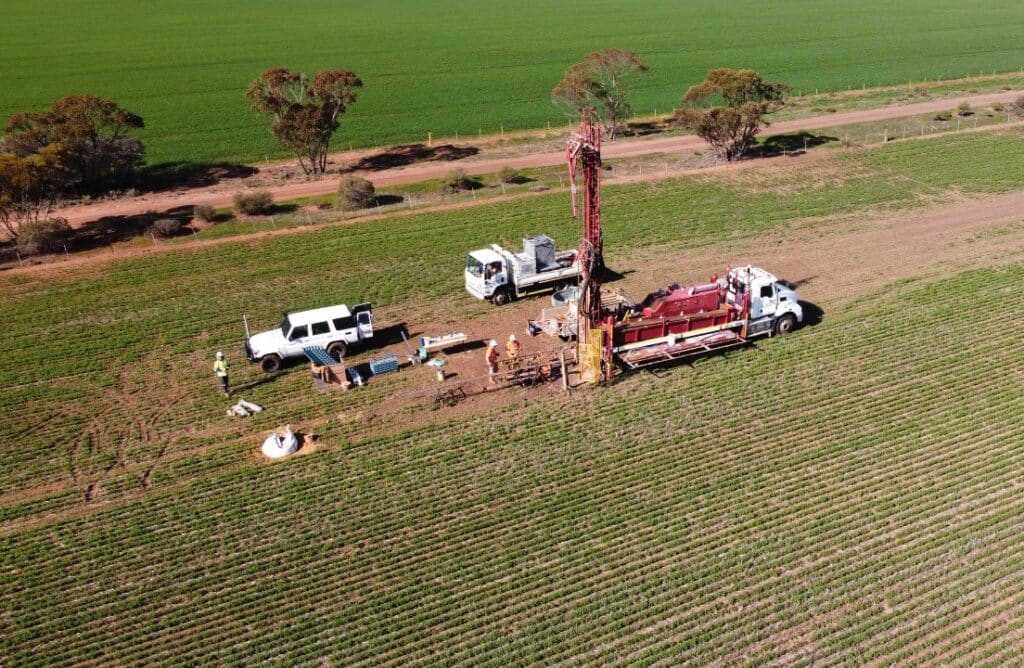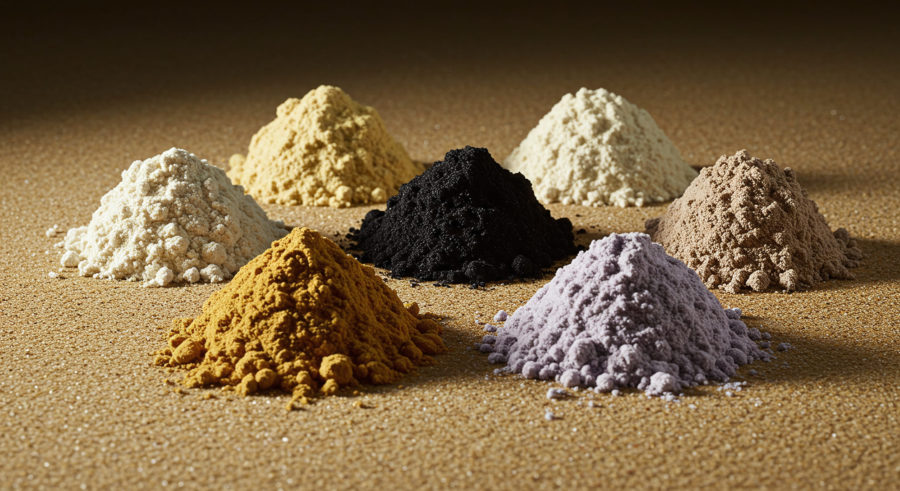This is how the Congo supplies ‘conflict minerals’ to the IT world

National Geographic describes miners in Congo as “an antlike army expending millions of calories and gallons of sweat to feed a vast and distant global industry”.
If you are reading this on a tabloid or a smartphone, then you are likely holding bits of so-called “conflict minerals,” mostly mined in the Democratic Republic of Congo (DRC), where National Geographic travelled recently to investigate the current state of the country’s mineral trade.
In the October 125th Anniversary issue of the magazine, Jeffrey Gettleman and photographer Marcus Bleasdale document the horrifying conditions under which the country’s miners still work to produce near half of the world’s supply of tantalum, as well as an important amount tin ore, tungsten, gold and dozens of other minerals used in today’s most popular electronics.
Described by Bleasdale as “an antlike army expending millions of calories and gallons of sweat to feed a vast and distant global industry,” the majority of these people work for militia groups that still control most of the country’s mines.
Unlike legitimate countries that export tantalum, the Congo is a nation dominated by warlords who slaughter innocent people in order to take land that is rich in highly demanded minerals, including cobalt, gold diamonds, copper and tin.
For much of the past decade, cheap supplies of tantalum, derived from these mines have flowed into a long and complex supply chain, involving infamous groups, such as the Hutu militia associated with the 1994 Rwandan genocide.
U.S. intervention
In an effort to curb the imports of tainted minerals from the beleaguered African country, the US and the Securities and Exchange Commission (SEC) passed last year a set of strict rules requiring manufacturers to report from where they get its tantalum, tin, gold or tungsten. It also forces companies to disclose payments made to overseas governments to develop natural gas.
While the ruling goes into effect in 2014, more than a third of US firms are absolutely unprepared to adopt it, revealed a poll conducted in April during the IHS webinar “The Clock’s Ticking: How to Comply with the New Conflict Minerals Regulations.”
What’s more, the US biggest manufacturing trade groups — the Chamber of Commerce and the Business Roundtable— began an ongoing court battle against the SEC, aimed to stop the rule from taking effect.
In late July, Judge Robert L. Wilkins decided to upheld the SEC’s rule, to which the US companies replied by filing this month a brief that includes pretty much the same arguments defeated earlier in the year.
The upcoming verdict, expected anytime this fall, will determine whether US firms can use conflict minerals without telling consumers and investors what is the nature of the electronic components used in the next best-seller tabloid or smartphone.
- Take a look at “The Price of Precious” photo gallery from National Geographic
- Learn more about conflict minerals:
Images from “Conflict Gold 101” video/Courtesy of ENOUGHproject.
More News
Japan sets sail on rare earth hunt as China tightens supplies
January 11, 2026 | 04:22 pm
Australia’s VHM scraps offtake deal with Shenghe Resources
January 11, 2026 | 04:08 pm
{{ commodity.name }}
{{ post.title }}
{{ post.date }}






10 Comments
Mark Patzelt
Again and again we see this kind of article in different media pointing the finger to the appaling situation and undescribable conditions under which these conflict minerals are mined. I am a mineral trader specialised exactly in these minerals and he have been operating within Congo for many years until the SEC ruling has hit Eastern Congo and stopped all legal operations in 2010. Of course it has not stopped operations as world demand has not stopped and can not be substituted by other sources. All operations have gone illegal and the material is today whitewashed in Rwanda and Katanga, countries and regions that habe been cleared to be so called “Conflict Free”, which is of course not changing anything for the kids in the pits and the raped women. It only soothes the bad concious of western consumer, or at least it is supposed. Like with all “Prohibitions”: if there is serious demand, there is always a way and all that is achieved by the SEC was to push the prices up the the activity underground. The SEC ruling has ruined all economic activity in the this heart of dark and has caused even more conflict and pain. As with all drugs, they have to become legal if criminals are to be run out of town. And a drug this Tantalite is, or are you willing and able to switch off your smartphone, smartpad or notebook and live without it?
Jaco de Klerk
I am also involved in the mining of tin and tantalum , however the hypocrisy and double standards applied by the Western world to Africa is simply unbelievable. I lived in the DRC for 3 years and yes, the so-called Secret Service threw me in jail for 18 days trying to extort money from me to pay for the new pick-up of the Provincial Chief of ANR. But as a whole, the only people that really suffer, are those poor buggers trying to make a living digging 12 hours a day earning U$ 50 cents per day to somehow feed their families. So what does the West do, make it even more difficult for the poor artisanal digger and easier for the fat cats to make even more money. Go in and help develop the mines instead of sitting on the side bleating like sheep. Paying taxes to “government officials” is simply another way of extortion. The poor will never get anything. The biggest crooks or deluded self enrichment schemes are the so-called NGO’s . They create problems to organise nice cushy well paid jobs for themselves. I have personally witnessed MONUC planes loaded with tin and gold taking off from a small unknown airfield in Katanga province. The whole way of thinking about controlling the supply is wrong. Assist the poor miners instead of fat cats.
frankinca
Thanks for the eye opening , on the ground observations. The US tries to use economic ways to solve foreign governmental and societal problems and mostly causes worse for the workers. Like India and the gold import problem, a more reasonable solution to African workers problems has to be worked out. Who in the US is in charge of these rules that are not well thought out. I wish I knew?
.
Mark Patzelt
I could not agree more with Jaco. Today the parasitic NG organisations have gotten a taste of the good money to be made in certifying conflict free origin of minerals. They have made a lot of money in Rwanda and in Katanga, where 1 Mio USD was put on the table by some traders and it took only 2 weeks to have a certification process installed. Everybody who knows the DRC a little knows how much of a joke all of this is. In Rwanda minerals from all over the region, like the Kivu’s, Burundi, Tanzania an Uganda are chanelled into Rwanda where the famous tags of the ITRI iTSCi sytem can be bought for just 10 USD. Looking at the magical increase in the epxort statistics of Rwanda is more than enough to show anybody willing to see that this system is just feeding so called “consultants” & “experts”. All surrounding nations are forced in to illegal mining activities as their production can not be sold officially to world markets, except of course, if they pay the certification experts their humble fees – for certification of Uganda with a production of 12t Tin in 2010 they asked 600.000 USD per year and cashed a tidy some of 37.400 USD for a sceleton fact finding mission. Today every week 3-4 expert groups are knocking on the door of governments around DRC to offer their services. It all boils down to a simple question which points to the illness of the NGO system all together: why do I want to solve a porblem that feeds me so nicely? There is no way around curing the decease right at the root: lifting the DRC out of its failed state, curbing corruption and help set up a proper education system instead of feeding a behemoth of 17.000 UN employees with nice salaries an bonuses who are idle bystanders when children are slaughtered and women are raped. The US, prentending to be the beacon of freedom and guardian of human rights is fuelling this conflict with its ecenomic ban that has driven all legal mining into the hands of warlords and government troops. One would wish to see the SEC ruling toppled this fall, but as the old saying goes: whatever looks to be too good to be true usually is.
some guy
hi
Kithinji kwiriga
I am surprised all the commentators on this discussion are forigners.they tend to lay the blame on local congelse.i am sorry conflict in minirals in Congo started with entry of Belgium colonial rule.they massacred and enslAved the local people in order to steal and plunder their resources.by taking arms the people had enough and they were ready to defend their resources at all cost having wAtched their people get massacred and their resources being stolen over centuries. Blame the defenceless unsolfiscated local people.the real criminals are foreigners sitting in Europe and America where the minirals end up.
Kithinji kwiriga
I watched the video on conflict minirals produced by national geographic and concluded this another western propaganda agent to justify the continued plunder of congolese redources by the west.of all the time he spent tAlking he did not produce one congolese to corroborate his claims death theft rape and what have yu. I am certain that this video was not produced in Congo but in america.i am also dubious the photo shown is not from congo..the other thing he only talked of selected minirals.whar about the rest.who mines uranium , diamonds or oil?How many congolese people are employed in those minines?How much is Congo gov paid? Of course he cannot mention those because they are owned either by Americans or europeans and they are deemed clean.we also want to see the pictures of the mines I have mentioned.
Kithinji kwiriga
I am amazed of all the reporting about minerals and conflict in Congo is done by foreigners especially from America and europe.they pretend to know so much even more than the local people themselves.the question is are congolese so damn that they cannot talk for themselves?My opinion is this made deliberate to mAnufacture propaganda ,conflicts which do not exist so that the west can continue plunder and stealing of vast congolese redources
Kithinji kwiriga
Of course the so called conflict minirals end up in gagdets manufactured by Americans and europeans.it is of their interest to fuel all these conflicts to keep the prices as low as possible so that they can reep maximum profits.yA fuel the conflicts because most of deadly weApons are manuctured and trafficked by the americans and europeans.these know it all reporters have never told the congolese people who makes these deadly weApons and how they find their way to country.
Kithinji kwiriga
These fake western reporters should tell the world and congolese people the truth.the real victims are congolese and
The perpetrators of all the horible crimes are the west. It has remained so even today.since Slavery they have suffered mass depopulation,during colonialism (murder,rape,enslavement and theft of their vast resources) their wildlife was decimated by European poaching.the tendency always has been to blame the victims instead of the real criminals.